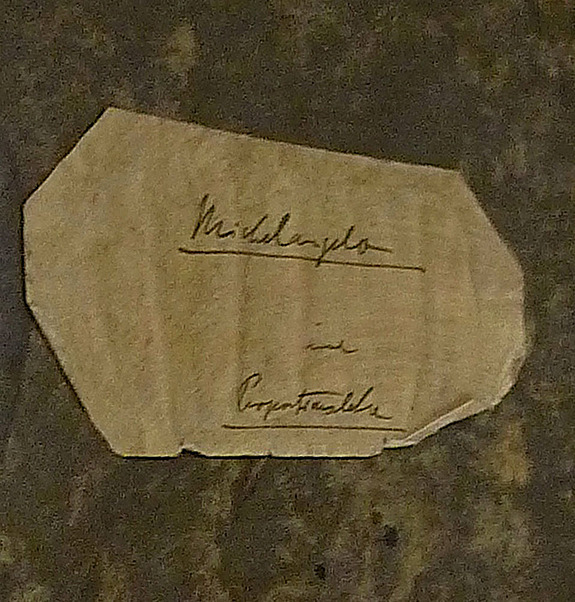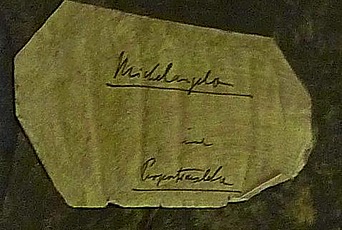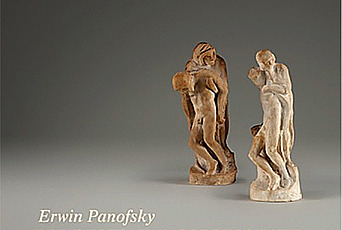A Fortuitous Discovery

In June 2012, an early work by Erwin Panofsky (1892–1968) was found in an armored cabinet in the basement of the Zentralinstitut für Kunstgeschichte in Munich. The study, “Die Gestaltungsprincipien Michelangelos, Besonders in ihrem Verhältnis zu denen Raffaels” (“Michelangelo’s Principles of Style, Especially in Relation to Those of Raphael”), fills a gap within the extensive list of publications of one of the most eminent art historians of the twentieth century.
Many knew about it, many looked for it, but no one was able to find it. Assumed lost in the bombing of Hamburg during World War II, Panofsky’s manuscript on Michelangelo, written at the end of the second decade of the twentieth century, had become a legend, a mystery that, as the years went by, was less and less likely to be solved. Not even the correct title had been preserved. All that was known was that during the late spring of 1920, Panofsky’s study had been accepted as his Habilitation thesis by the Faculty of Philosophy of the University of Hamburg, and after the required additional examination, Panofsky had received the venia legendi. Then the manuscript vanished, until now, when it reappeared in the most unlikely place, a safe in the basement of what used to be the administration building of the National Socialist German Workers’ Party in Munich. What had happened? This account attempts to reconstruct the history of the manuscript based on information gathered from publications like the Erwin Panofsky Korrespondenz 1910–1968 (ed. Dieter Wuttke, 5 vols. [Wiesbaden, 2001–11]), Horst Bredekamp’s article “Ex nihilo: Panofsky’s Habilitation” (in Erwin Panofsky: Beiträge des Symposions Hamburg 1992, ed. Bruno Reudenbach [Berlin, 1994], 31–51), and recent newspaper articles as well as critical details provided by Gerda Panofsky, Erwin’s second wife and widow, and Stephan Klingen from the Zentralinstitut.
There is no evidence illuminating the impulse that led to the selection of the Habilitation’s topic other than the lectures and seminars on Michelangelo that Panofsky had attended at the Königliche Friedrich-Wilhelms (now Humboldt)-Universität in Berlin; nor is it known when exactly Panofsky began working on the manuscript. After earning his doctoral degree at the University of Freiburg in July 1914, he spent the next few years publishing his dissertation and writing several articles. At the outbreak of World War I, he had been drafted into the army, but owing to a riding accident soon afterward, he was declared unfit for service at the front. In the spring of 1917, however, he was deemed fit for duty at the home front and was assigned a governmental job in Kassel and then in Berlin with the authority distributing coal to the civilian population. The demobilization finally freed him from military service in January 1919.
While working for the distribution authority in Berlin in December 1918, he put in an application for Habilitation at the University of Heidelberg. As a Habilitation thesis he offered either to present “Dürers Kunsttheorie, vornehmlich in ihrem Verhältnis zur Kunsttheorie der Italiener,” which had been published in 1915 and was the expanded version of his dissertation (only pages 122–180 had been submitted as his dissertation thesis in Freiburg/Breisgau), or the heretofore unpublished study on the “Westbau des Doms zu Minden” (later published in Repertorium für Kunstwissenschaft, vol. 42 [1920], 41–77). In case neither work would be accepted, he proposed to extract a partial topic from his current research and develop it into a larger, more extensive study. Three months later, on March 30, 1919 (his twenty-seventh birthday), he withdrew his application because of unexplained extraordinary circumstances. In August of the same year, he was working on a presumptive Habilitation for the University of Tübingen and hoped to travel to Southern Germany to present the finished thesis at the beginning of winter. It is not known if Panofsky had chosen to expand his study on the cathedral of Minden or if he had moved on to a different subject.
When, in December 1919, the Director of the Kunsthalle Hamburg, Gustav Pauli, asked him if he would be interested in lecturing on art history at the University of Hamburg, Panofsky emphasized in his response that in accepting he also meant to apply for his Habilitation. At this point, the process accelerated. In a letter addressed to the Faculty of Philosophy of the University of Hamburg, dated Berlin, March 11, 1920, Panofsky writes that after leaving the military he had concentrated on working mostly on the subject of Michelangelo’s style and that he was submitting the completed first part of this project (whose second part he was to finish by the end of the year) with his application for Habilitation. Nine days later, Pauli informed Panofsky that he was reading his thesis. Obviously impressed by what he had seen so far, he encouraged Panofsky, in confidence, to rent the prospective apartment in Hamburg. Thereafter, the communication ceased for a period of almost three months, enough time for Panofsky to voice his concerns in a letter to Pauli stating that he had not yet heard anything officially from the university and asking advice on how best to proceed. His concerns, however, were unfounded. Pauli had presented his evaluation on May 10, 1920, to the mandated committee that had been formed for the Habilitation procedure. The other members, Max Lenz, Ernst Cassirer, and Otto Lauffer, concurred with Pauli’s positive evaluation between May 25 and June 3. In a meeting of the Faculty of Philosophy on June 19, the approval was accepted and July 3 was decided upon as the date for Panofsky’s Probevorlesung. This trial-lecture on the topic of “Die Entwicklung der Proportionslehre als Abbild der Stilentwicklung” (published 1921) completed the Habilitation process. Panofsky was awarded the venia legendi and was thus able to begin teaching in Hamburg.
It is around this time that the manuscript disappeared. The author mentioned his plans to edit the Michelangelo text once more in a letter to his wife Dora on July 3, 1920. More than forty years later, Egon Verheyen wrote to Panofsky inquiring about the thesis after seeing it cited in a footnote in an article by Gert van der Osten, then Director-in-Chief of the Cologne Museums. Panofsky recalled the exchange with van der Osten and answered on January 28, 1964, “My ‘Habilitationsschrift’ was concerned with the stylistic principles of Michelangelo, seen against the background of the development of art from Egypt to Bernini [ . . . ]. The original manuscript is lost [ . . . ].” (E. P. Korrespondenz, vol. 5, 440).
Long before the manuscript was rediscovered or Panofsky’s correspondence was published, Horst Bredekamp’s 1992 lecture sought not only to give a detailed account of its early history, including a copy of Pauli’s evaluation of the text—the only written testimony that had been preserved—but also set out to carefully search for traces of the content as well as examine if and where parts of it might have been incorporated into Panofsky’s later publications. Pauli’s evaluation mentioned neither the title nor the size of the work. The recently discovered manuscript finally provides these details: aside from the aforementioned title, we now know that it is comprised of 334 pages, of which about 50 percent is typewritten text, and the other half handwritten additions. According to Gerda Panofsky, the text was verifiably edited and expanded until at least the end of 1922. Written before the invention of the photocopy machine, this was the author’s own and only copy, which he had labeled “Michelangelo I. Exemplar.” It is possible that after the Habilitation procedure was completed the typescript had been returned to the author for final revisions.
Pauli’s evaluation had previously allowed some insights into its content, in which Panofsky tries to define the uniqueness of Michelangelo’s style by comparing his works with those from antiquity (including Egyptian art), the Quattrocento, his contemporary Raphael, and the Baroque. According to Panofsky, Michelangelo was not a predecessor of the Baroque; if anything he was perhaps a brother of the Baroque. It may seem surprising that Panofsky applied a method associated more with that of his teacher Heinrich Wölfflin, who used the history of style and motifs to analyze a work of art, an approach Panofsky had earlier criticized in his article “Das Problem des Stils in der bildenden Kunst” (1915). Yet, he had always highly respected Wölfflin. Moreover, the reemerged manuscript may also show that Panofsky did not cling literally to Wölfflin’s principles, but that, according to Bredekamp, “he obviously highlighted Wölfflin’s bipolar organized principles of style with a view of Michelangelo in their potential for conflict. This should not be seen by itself as an application of Wölfflin’s method. It is an independent development” (interview in Jewish Voice of Germany, September 22, 2012).
What were Panofsky’s plans for his Habilitation thesis? Bredekamp acknowledged that it is not rare to utilize a Habilitation thesis as a kind of quarry for other works and provided numerous examples demonstrating how Panofsky revisited the Habilitation’s thesis whenever his research focused on Michelangelo. Panofsky himself referred to his “Habilitationsschrift” “as a much too ambitious attempt” and while it had not been published, he stated he had incorporated some of its ideas in his later work.
Panofsky wrote for the last time about Michelangelo in the chapter “The Neoplatonic Movement and Michelangelo” of his Studies in Iconology (1939), the Mary Flexner Lectures he had given at Bryn Mawr College in 1937. A comparison of this publication with the rediscovered Habilitation thesis reveals similarities to the earlier work. Panofsky may have taken some notes with him when he left Germany in 1934 after all, because even his excellent memory would probably not have been able to retain so many details.
The Habilitation thesis itself had certainly been left behind in Germany. Panofsky spent the years until 1930 in the Hanseatic city teaching, writing, and developing the Institute of Art History at the University of Hamburg, and, at least until 1922, also revising and annotating his Habilitation thesis. From 1931 to 1933, he lectured alternate terms at Hamburg University and at New York University’s Institute of Fine Arts. The Hamburg appointment came to an abrupt end on April 7, 1933, with the enactment of the Law for the Restoration of the Professional Civil Service (Gesetz zur Wiederherstellung des Berufsbeamtentums) that allowed tenured civil servants to be dismissed. Jews and political opponents could no longer serve as teachers, professors, judges, or in other government positions. Panofsky happened to be in New York at the time of the enactment of the law. Upon his return to Hamburg in May 1933, he decided to continue supervising the dissertations and oral exams of three of his Jewish graduate students who had almost completed their course work. However, he held these sessions not at the university—although his office and the art history seminar at the time were actually located at the Hamburger Kunsthalle—but at his private apartment. Thus, if his Habilitation thesis was in his room at the seminar, into which he refused to set foot, he never retrieved it. His official dismissal from the University of Hamburg occurred on June 28, 1933, to the chagrin of many members of the faculty and the students.
The manuscript’s fate from then to its 2012 reemergence in Munich becomes even more enigmatic. Ludwig Heinrich Heydenreich belonged to the first generation of students who had studied with Panofsky in Hamburg and, thus, a special bond existed between teacher and his pupil that would last a lifetime. Heydenreich had completed his own Habilitation at the University of Hamburg in 1934, and, in the following years, he was entrusted with the management of the art history seminar before taking up a teaching position in Berlin in 1937. In 1943, he assumed the Directorship of the German Kunsthistorisches Institut in Florence and, after the war, he helped found the Zentralinstitut für Kunstgeschichte in Munich, becoming its first Director in 1947. He retired in 1970 and died in 1978. It was in the basement of this building that the manuscript was discovered. The building, erected in 1934–35, had served as the Nazi Party’s headquarters and the safes had been used to store the party’s countrywide membership cards. After World War II, it became the “Central Collecting Point,” where American and German art historians worked on the collection, documentation, and restitution of artworks that had been confiscated or purchased by the Nazis.
At what point in time the manuscript was put into the armored cabinet together with other papers from Heydenreich’s term as Director is not known. Its rediscovery was purely by chance, because nobody was looking for Panofsky’s text in Munich. A few years ago, Gerda Panofsky began to work on a biography of the early years of her husband’s life, covering the period between 1900 and 1920. To complete her research, she made one final attempt in June 2012 to search for the Habilitation thesis. Like everyone before her, she was looking in the most likely place, Hamburg. Her inquiry resulted in precise information about Panofsky’s Habilitation process, but it also specified that the whereabouts of the thesis were unknown and that it was presumed that it had been destroyed during the bombing of Hamburg in 1943–44. In the middle of this exchange, Gerda Panofsky received an email from Munich with the subject-heading “Fund” (find), informing her of the discovery at the Zentralinstitut. She was stunned: Panofsky had no connection with Munich other than that he had studied there for a semester in 1911. For the scholars on the other side of the Atlantic, the discovery of the binder with the manuscript was no less astounding. According to Dr. Stephan Klingen, Head of the Photo Collection at the Zentralinstitut and the finder of the manuscript, there are about forty to fifty such safes in the building’s basement. These had been reused after World War II by the various academic institutions that had moved into the building. For two of these safes, the keys had gone missing, and it was eventually decided to have them professionally cracked open. One of them turned out to be empty; the other was filled to the brim with material from Heydenreich’s directorship. Panofsky’s manuscript was not immediately noticed. Only a request by a French scholar researching Heydenreich’s appearance at an event in France in 1940 (he had given a speech before German officers in Fontainebleau) prompted Klingen to look more thoroughly through the Heydenreich bequest, thus bringing Panofsky’s manuscript to light. After a check of Panofsky’s extensive bibliography, it became clear that the folder contained the art historian’s long-lost Habilitation thesis.
The topic of Michelangelo was raised at least one more time in a letter exchange between Heydenreich and Panofsky. Heydenreich had come to St. Louis, Missouri, as a Visiting Professor in 1948, and, in December of the same year, he wrote to Panofsky in Princeton. In this as yet unpublished letter, he asked for a meeting, but in the next paragraph, without transition, he implores Panofsky to write his [sic] Michelangelo book, as only he could do it and thus must [sic] do it (a scan of the letter, courtesy of the Archives of American Art in Washington, D.C., was obtained by Gerda Panofsky). Panofsky in his response stated very clearly that even though he felt flattered to be asked to write the definitive Michelangelo monograph, he had now moved on to other subjects. In February 1949, Heydenreich did visit the Panofskys in Princeton for a weekend as their houseguest, and he returned once more in the spring of the same year.
In another curious twist of events, Panofsky found himself, thirty-three years later, once again under the same roof as his Habilitation thesis. In July 1967, he came to the Bavarian capital to be awarded the Orden Pour le Mérite. Heydenreich, then still the Director, was instrumental in arranging the ceremony at the Zentralinstitut and actually placed the medal around Panofsky’s neck. Panofsky spoke fondly of his former student in his acceptance speech.
Many questions concerning the manuscript and its peculiar history cannot be answered satisfactorily until more evidence is discovered and the text is available. Did Panofsky indeed abandon his Habilitation thesis and its scholarly method as Willibald Sauerländer, who succeeded Heydenreich as Director of the Zentralinstitut, suggested in the Süddeutsche Zeitung on September 6, 2012? Moreover, the whereabouts of the manuscript between 1934 and 2012 as well as how and when Ludwig Heydenreich came into the possession of it will perhaps forever remain a mystery.
After the long-lost manuscript’s convoluted odyssey, a sense of continuity soon will be restored. In 1914, Erwin Panofsky’s dissertation thesis was printed in Berlin by the Georg Reimer Verlag, one of De Gruyter’s founding publishing houses. A century later, in 2014, his Habilitation thesis (edited by Gerda Panofsky) will be published by the same company. The manuscript’s extraordinary journey, for now, has reached its final destination.
–––––––––––––––––––
Recommended Reading: Erwin Panofsky (1892–1968) was one of the most significant and influential art historians of the twentieth century. The field of art history has a long tradition at the Institute for Advanced Study, beginning in 1935 with his appointment to the Faculty. Panofsky was a Professor until 1962, then served as Professor Emeritus until his death in 1968. His interests ranged across the spectrum from European Medieval and Renaissance art, to literature and motion pictures, but he is most closely associated with the development of the field of iconology. Panofsky described himself as a humanist, which he defined as somebody who rejects authority but respects tradition. To read more about Panofsky, visit www.ias.edu/people/panofsky.

